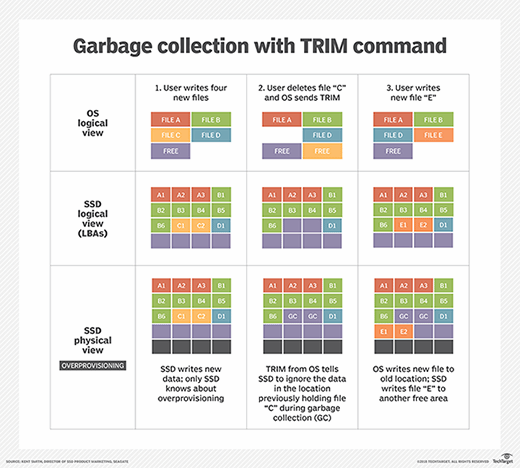I Know You Are Supposed to Trim an Ssd. Is It Safe to Defragment an Ssd?
SSD TRIM is an Advanced Technology Attachment (ATA) command that enables an operating system to inform a NAND wink solid-state drive (SSD) which data blocks it tin erase considering they are no longer in use. The utilize of TRIM can improve the performance of writing data to SSDs and contribute to longer SSD life.
TRIM, which is not an acronym, is available for SSDs that back up the Serial ATA (SATA) interface. UNMAP is the comparable Small Estimator System Interface (SCSI) command for use with SAS SSDs. The DEALLOCATE operation provides a similar adequacy in the nonvolatile memory express (NVMe) command gear up for Peripheral Component Interconnect Express SSDs.
The T13 Technical Committee of the International Committee for It Standards (INCITS) has incorporated the TRIM command into the ATA standard.
How information technology works
NAND wink-based SSDs read and write data in units known as pages, and in a typical SSD, 128 pages constitute a single data block. But, before any data tin be written or programmed to the SSD, an unabridged block of data that is no longer needed must exist erased. An internal SSD housekeeping operation known as garbage collection helps to streamline the process.

Garbage collection manages and maintains the available storage space, treatment the disparity between the erase unit size (cake) and the read/write unit size (folio). When a previously written block is targeted for garbage collection, the valid information pages are gathered up and moved to some other block on the SSD and so that the cake containing the erstwhile, invalid data pages can be erased. Garbage collection may await for lulls in drive activity to initiate the process, sometimes leaving pages that are obsolete in the SSD.
SSD TRIM is complementary to garbage collection. The TRIM control enables the operating organisation (OS) to preemptively notify the SSD which data pages in a particular block tin be erased, allowing the SSD'south controller to more efficiently manage the storage space available for data. TRIM eliminates any unnecessary copying of discarded or invalid data pages during the garbage drove process to save time and amend SSD operation.
The SSD TRIM control simply marks the invalid information and tells the SSD to ignore information technology during the garbage collection process. The SSD so has fewer pages to move during garbage collection, which reduces the total number of program/erase cycles (P/E cycles) to the NAND wink media and prolongs the life of the SSD. NAND flash wears out due to the long-term furnishings of the P/E cycle, so reducing the number of erases can lengthen the endurance of the SSD.
In order for TRIM to function, the host'due south Os and the SSD must support it. For case, in a Windows surround, when an SSD reports that it has TRIM support, the OS will disable deejay defragmentation and enable TRIM. When a user deletes a file, the Os sends a TRIM command to the SSD controller to tell information technology which data pages can be erased when the garbage collection process takes places. The TRIM command and the write command operate independently of each other. The user also has the option to initiate the TRIM control manually or schedule it on a daily basis.
The SSD TRIM command may meet issues with hardware-based RAID controllers due to the mode RAID breaks autonomously. SSD TRIM is less problematic when used with software-based RAID.
Benefits of using TRIM
SSD TRIM facilitates important benefits in the areas of performance and bulldoze longevity.
Using the TRIM command reduces the amount of data an SSD needs to move during the garbage collection process and reduces the amount of erase cycles, enabling the drive to last longer. By fugitive unnecessary copying of invalid data, the write operation of the drive speeds up.
SSD TRIM vs. defrag
SSD TRIM and hd drive (HDD) defragmentation are operations designed to improve drive performance and enhance storage efficiency, but they operate in different ways.
The process of HDD defragmentation enables a rearrangement of the fragments of data that plant a file into closer proximity to speed access. Consolidating the fragmented blocks into a contiguous group improves read performance by reducing the number of seeks the HDD's head must perform. Although the defragmentation procedure groups free infinite on the drive into a single face-to-face space, the full free space available is not affected.
SSDs do not have moving read/write heads and do not need traditional defragmentation. Use of the TRIM control helps to optimize the capacity of an SSD by allowing garbage collection and background processes to ignore the invalid or obsolete data. The finish result is faster data writes and reduced bulldoze wear.
This was concluding updated in Feb 2018
Go along Reading About SSD TRIM
- SSD firmware operation measurements for Windows 7
- A comparison of solid-country storage technologies
- Define SSD: Tiptop terms you demand to know
- The event of storage optimization practices on SSD adoption
- Factors that decide SSD operation
Dig Deeper on Flash retentivity and storage
-

solid-state storage garbage collection
-

How to perform Windows x disk optimization
-
![]()
How Zoned Namespaces Ameliorate SSD Lifetime, Throughput and Latency
-
![]()
Handling Wearisome Disks in Heterogeneous SSD Deployments
Source: https://www.techtarget.com/searchstorage/definition/TRIM



0 Response to "I Know You Are Supposed to Trim an Ssd. Is It Safe to Defragment an Ssd?"
Enregistrer un commentaire